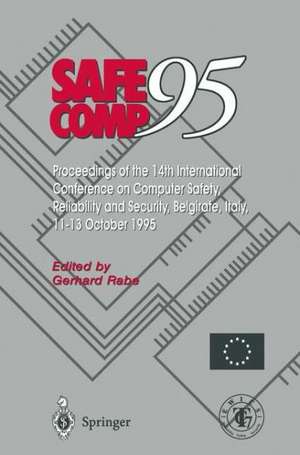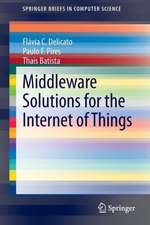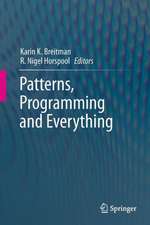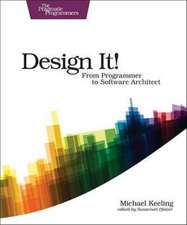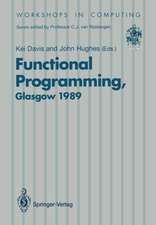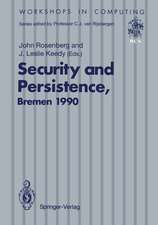Safe Comp 95: The 14th International Conference on Computer Safety, Reliability and Security, Belgirate, Italy 11–13 October 1995
Editat de Gerhard Rabeen Limba Engleză Paperback – 12 oct 1995
Preț: 344.10 lei
Preț vechi: 430.12 lei
-20% Nou
Puncte Express: 516
Preț estimativ în valută:
65.85€ • 71.50$ • 55.32£
65.85€ • 71.50$ • 55.32£
Carte tipărită la comandă
Livrare economică 22 aprilie-06 mai
Preluare comenzi: 021 569.72.76
Specificații
ISBN-13: 9783540199625
ISBN-10: 3540199624
Pagini: 532
Ilustrații: XII, 516 p. 59 illus.
Dimensiuni: 155 x 235 x 28 mm
Greutate: 0.74 kg
Ediția:1st Edition.
Editura: SPRINGER LONDON
Colecția Springer
Locul publicării:London, United Kingdom
ISBN-10: 3540199624
Pagini: 532
Ilustrații: XII, 516 p. 59 illus.
Dimensiuni: 155 x 235 x 28 mm
Greutate: 0.74 kg
Ediția:1st Edition.
Editura: SPRINGER LONDON
Colecția Springer
Locul publicării:London, United Kingdom
Public țintă
Professional/practitionerDescriere
Safety-related computer systems are those which may lead to loss of life, injury or plant and environmental damage. Such systems therefore have to be developed and implemented so that they meet strict require and security because their applications cover ments on safety, reliability nearly all areas of daily life and range from controlling and monitoring industrial processes, through robotics and power generation, to transport systems. Highly reliable electronic systems for safety-related applications represent an area in which industry has been involved for many years and which is now gaining increasing importance in academia. Their relevance also results from an increased perception of safety by society. Therefore, not only are technicians involved in this area, but psycho logical and sociological aspects also play a major role. Dealing with safety-related systems we have to consider the whole lifecycle of these systems, starting from specification up to implementation, assessment and operation. All those issues mentioned above are covered in this book, which represents the proceedings of the 14th International Conference on Computer Safety, Reliability and Security, SAFECOMP '95, held in Belgirate, Italy, 11-13 October 1995. The conference continues the series of SAFECOMP conferences which was originated by the European Workshop on Industrial Computer Systems, Technical Committee 7 on Safety, Security and Reliability (EWICS TC7) and reflects the state of the art, experience and new trends in the area of safety-related computer systems.
Cuprins
Session 1: General Issues, Guidelines.- Software Best Practices in Dependable Systems: The European Research Projects ENCRESS, OLOS and ESPITI From a Partner’s Perspective.- Assessment on the Basis of Standards - Gaps and How to Bridge Them.- Session 2: Safety Analysis.- Safety Analysis for Requirements Specifications: Methods and Techniques.- A Guideline for HAZOP Studies on Systems Which Include a Programmable Electronic System.- An Automated Code-Based Fault-Tree Mitigation Technique.- Session 3: Formal Methods.- Formal Support for the Safety Analysis of Requirement Models.- Modelling Fault Trees Using Petri Nets.- The Application of Formal Methods to Railway Signalling Systems Specification and the ESPRIT III Project CASCADE.- Accessible Formal Method Support for PLC Software Development.- Session 4: Human and Legal Aspects.- Eliminating the Unexpected.- Cognitive Diversity: A Structured Approach to Trapping Human Error.- Legal Aspects of Safety Critical Systems.- Invited Paper.- A Bayesian Model that Combines Disparate Evidence for the Quantitative Assessment of System Dependability.- Session 5: Design.- Six Steps Towards Provably Safe Software.- Formally Verified Firmware Modules for Industrial Process Automation.- Session 6: Assessment.- Programmable Electronic Controllers (PEC) Performance Assessment - An Approach for Reliability Quantification.- BOOTSTRAP: Software Process Assessment - Experiences and Further Developments.- Analysis and Assessment of Advanced Road Transport Telematic Systems.- Session 7: Safe Software.- Loops for Safety Critical Applications.- Ontario Hydro’s Experience with New Methods for Engineering Safety Critical Software.- Is Software Safe to Fly?.- Session 8: Applications I.- A Software Development Approach for Robotics Control Systems.- An Attempt to Evaluate Functional Diversity Employed in a Reactor Protection System.- Requirements Analysis and Safety: A Case Study (Using GRASP).- Session 9: Applications II.- Neural Nets and Diversity.- On-Line Software Error Detection by Executable Assertions: From Theory to Practice.- The Use of Animated Graphical Simulation Techniques to Facilitate Safe Operation, Assembly and Disassembly of Safety Critical Equipment and Systems.- Invited Paper.- An Industrial View of Requirements Engineering and Safety.- Session 10: Case Studies.- Safety Cases for Software Application Reuse.- The SHIP Safety Case Approach.- Safety Case: Structure and Role.- Session 11: Validation and Verification.- Practical Approach for the Evaluation of Safety Related Programmable Electronics.- An Experience in Formal Verification of Safety Properties of a Railway Signalling Control System.- Dependability of Iterative Software: A Model for Evaluating the Effects of Input Correlation.- The Verification of Compiled Code.- Author Index.
